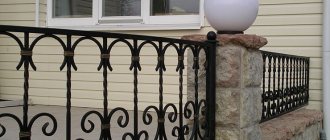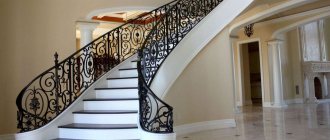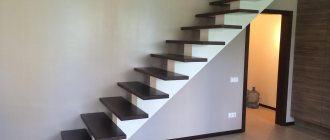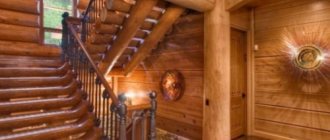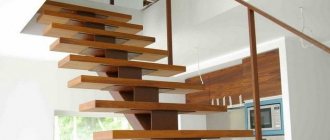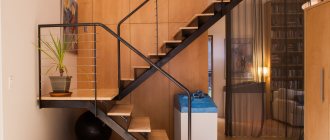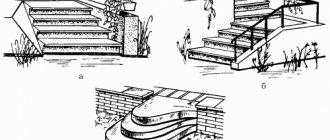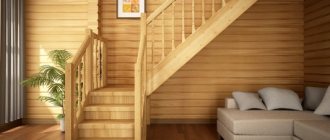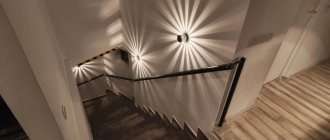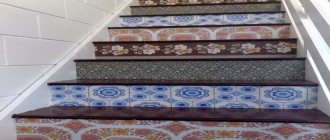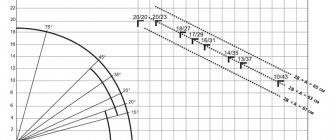The staircase should fit harmoniously and naturally into the overall stylistic concept of the room
The railing of a country house staircase is a multifunctional and important part of the staircase structure as a whole, which should not only ensure safety when going upstairs, reliably protecting against falling, but also be aesthetically attractive, fitting harmoniously and naturally into the overall stylistic concept of the room.
Unusual staircase with glass railings in a modern interior
Staircase with elegant railings in art deco style
A railing is a fencing for staircase flights, which, on the one hand, protects the person climbing (descending) from falling, and on the other, serves as a support when climbing, which is especially important for older people. The fencing structure consists of the following elements:
Art Nouveau railings
- balusters are support posts to which the handrail is attached. They perform both a practical (load-bearing) function and a decorative one.
- handrails are an element used as support when moving up stairs. Can be installed on two or one side of a flight of stairs, and can be attached either directly to the wall or to balusters
Victorian style wrought iron staircase
- fence fillers - an element that fills the space between balusters. Often they perform a purely decorative function and in some designs, especially in modern styles, fillers are completely abandoned. However, if there are children in the house, they are required for installation - their presence significantly increases the safety of moving up the stairs.
According to current regulations and standards, the minimum height of handrails on stairs must be at least 90 cm. If the width of the stairs exceeds 1.25 m, handrails must be installed on both sides.
The presence of fillers significantly increases the safety of movement on stairs
Advice! If there is a child in the house, then the distance between the balusters is selected so as to exclude the possibility of sticking their head between them.
Railings for stairs: selecting material
If the design of the staircase is simple in execution and there are no special design requirements for the railings, then they can be made of simple materials. Another thing is a staircase of an exclusive design or which acts as a central detail, bearing the main decorative load in the interior - here the railings will have to meet increased requirements. Otherwise, the simplicity and unpretentiousness of the railing design will spoil the whole effect. Therefore, it is important to choose the right material from which the staircase railings will be made (photos make it possible to compare different options). In this case, it is important to follow two rules - compliance with style and unconditional compliance with safety requirements.
Railings must be in style and meet safety requirements
What elements should be present in the railings for spiral or marching type stairs?
Regardless of type, railings consist of three main elements:
- support pillars;
- balusters or filling;
- handrails
Support pillars on flight stairs are attached at the beginning and end of the flight, as well as at the corners of the turning platforms. On screw structures, supports are located at the beginning and end of each bend. It is with the help of these elements that the staircase is given strength. The distance between the support pillars is usually within 50-60 cm.
Metal balusters for stairs are considered optional elements, because they play a decorative role. It is with the help of balusters that the space between the supporting pillars on the steps and the bowstring is filled. Despite the fact that the elements are installed only to complement the interior, they can also increase the safety of the structure and prevent injuries. For example, for small children who like to climb where they don't need to, the padding will be an excellent barrier to prevent them from falling down the stairs.
The attractiveness of stair railings will primarily depend on the shape, material, installation method and the distance between the internal elements. If there are no children in the house, it is quite acceptable to leave the space between the pillars free. If there are children in the apartment, you need to be very careful that the child cannot, under any circumstances, stick his head between the elements.
The attractiveness of railings for stairs depends on the shape, installation method, material and distance between internal elements
Important! It is recommended to maintain a distance of 7 to 15 cm between internal parts.
The height of the handrail usually ranges from 90 to 110 cm. Here everything will depend on the average height of the residents of the house. At the same time, designers emphasize that children should not be taken into account, since they grow quickly. If desired, you can attach a temporary option parallel to the main handrail, which will make using the stairs comfortable for children. If the stairs are wide, it is recommended to install handrails on both sides.
There are different ways to fill the space between the support pillars. Some people prefer to use openwork elements, others prefer solid wide panels with patterns, drawings, or options for combining various materials. To fill the internal space, some people purchase crossbars (rails) - metal rods installed not vertically, but horizontally.
Metal railings
A very popular option, in no small part due to the large number of design options - from simple, minimalist ones, consisting only of posts and railings, combined by welding, to very complex structures. They can be made of steel, iron, aluminum, and also in combination with other materials - glass, PVC, wood. You can use any type of metal profile - from fittings and simple pipes to profiles with complex patterns. They are very durable, resistant to dynamic and static loads - even the thinnest handrails can withstand high pressure. They can be used both indoors and outdoors. At the same time, metal stair railings (photos will serve as proof of this) in addition to the main one - protective, also do an excellent job of decorative function.
Metal railings are a very popular option.
Metal railings in a country style interior
Bright and interesting staircase in retro style
Type of railing
As we said earlier, railings come in many different shapes as well as colors. This is exactly what we will talk about now.
Interior. Such stair railings are located indoors. This type is characterized by light colors, the material of which is often wood or glass.
Exterior. Such structural stairs are located outside the building. Since such railings must withstand any weather well, they are made mainly of metal or concrete.
Remember that the shape of the railing depends on the material itself and its quality.
So, if the room is in a classic style, then the railing material should be made of wood. Well, if the room is in high-tech style, then the railings can be made of metal. The glass design is more suitable for modern style.
Wrought iron railings
They are often installed to favorably emphasize the chosen style of decorating a room, so they are most often used in the style of Rococo, Baroque and traditional classics. In addition to elegance and beauty, forged elements look elegant and sophisticated, which is often lacking in wood fragments. Typically, such railings are easy to perceive and visually “transparent”, thus the staircase does not consume space. Forged staircase railings will get additional charm if you use gold, silver or platinum finishes.
Wrought iron railings perfectly emphasize the Mediterranean style
Forged railing elements look elegant and sophisticated
Forged staircase railings will get additional charm if you use gold, silver or platinum finishes.
Some ideas for creating beautiful metal railings
When choosing railings, you need to take into account not only individual wishes, but also the harmonious combination of products with the interior. Some stairs look original without railings, but the question of safe use remains open. Therefore, it is better to supplement any design with handrails. Attractive design options:
For a classic interior with elements of aristocracy, forged and cast railings are best suited
- cast iron stairs look bulky and massive, but are not suitable for every interior;
- forged and cast railings will fit into a classic interior with elements of aristocracy;
- various patterns will fill the room with a palace motif;
- an openwork version of metal railings will add lightness to the staircase and transform any design
- a wooden staircase with metal railings will emphasize the rustic style, chalet interior or classic style;
- Using a variety of weaves, shapes and geometric shapes will help create a real work of art in the house.
A staircase is an integral element of a house or apartment of several floors. The entire structure is a continuation of the interior. Railings that continue the pattern of the walls will look very beautiful and harmonious. When choosing a railing design, you should not forget about safety rules. Metal is a durable material, but even despite this, you should properly install the railings and take care of them, only in this case you will be able to create not only a beautiful, but also a safe interior.
Stainless steel railings
Perhaps the most reliable and durable, primarily due to the manufacturing features. Such railings are usually made using the welded method, i.e. They are not collapsible, so they can withstand very heavy loads. In addition, they are durable - the stainless steel coating will reliably protect the metal from corrosion, plus no periodic touch-up is required. Stainless steel railings will harmoniously fit into modern (high-tech, minimalism) interiors.
Due to the manufacturing features, stainless steel railings are very reliable and durable
Very stylish railings in the form of spread mercury
Stainless steel railings will harmoniously fit into a modern interior
The main materials used to make railings: photos of exquisite options
There are various types of metal stairs that are installed outside or inside buildings. Based on the installation method, structures are divided into stationary and mobile. Mobile options are mainly needed only for repair or household work; this also includes stepladders. Popular designs are folding or sliding systems, which are used to climb into the attic or attic floor. Let's take a closer look at other types of stairs.
Marching. They are among the most convenient from a safety point of view for the movement of people. The structures consist of straight spans. If it is necessary to make a turn, platforms or winder steps are installed. It is not recommended to make more than 15-16 steps in one flight.
Screw. Another name is spiral stairs, which look not only beautiful, but also aesthetically pleasing. The turn is formed by smoothly curved structures. Spiral staircases are considered safe and convenient. They will not only decorate the room, but will also become an element that allows you to properly organize your movement.
When choosing material for railings, not only the preferences of the owners, but also the budget play a significant role
To make stairs and stair railings, various materials and technologies are used. A significant role in the choice is played not only by the personal wishes of the household, but also by the budget allocated for the manufacture of railings. In most cases, metal is used to create the main elements, as well as wood, which is also great for creating fences that match any interior design.
The main advantage of wooden railings is the ability to decorate them with carved or patterned details. In addition, you can use different shades of wood to make them. But wooden products will never be able to compare in strength to metal ones, which are guaranteed to last longer. Metal handrails for stairs can be made from available materials:
- pipes;
- fittings;
- metal profile;
- welded elements.
If you look at the photos of the finished options, you will notice that the railings look most attractive when complemented by decor, which includes plastic, glass, textiles, ropes and other suitable materials.
Metal stair railings can be made from pipes, profiles, fittings and welded elements
Features of handrails for stairs to a house, made of ferrous metals and cast iron
The most economical option for a porch, balcony or staircase railing is considered to be a ferrous metal fence. As you know, materials have some disadvantages, but to improve performance, powder coating or enamel is applied to the surface of the products. This allows you not only to give the handrails strength, but also to choose the desired color.
Fences can be used to equip multi-storey buildings, offices and residential buildings. Cast iron structures are in harmony with steps made of various materials; they look especially good in combination with cladding wood and marble tiles. At the same time, ready-made options may have a simple appearance or have an unusual design.
Cast iron railings are ideal for a balcony that faces the street, because the products are resistant to temperature changes and exposure to direct sunlight. It is the increased performance qualities and attractive appearance that make cast iron fencing the best option for the home.
Helpful information! Railings made of ferrous metal are susceptible to corrosion, so it is recommended to apply protective compounds to the products from time to time.
Ferrous metal railings are recommended to be periodically treated with protective compounds
If the artistic casting method is used for manufacturing, unusual weaves and patterns can be made from cast iron. The finished structure looks light, but at the same time emphasizes the richness of the structure. Almost all products are made according to a unique design, where each element is an integral part of the composition.
Related article:
Stainless steel railings: types, features, installation and care
Requirements for railings. Advantages and features of use. What types of railings are there? Self-installation and maintenance.
Using the method of casting and forging, craftsmen produce real works of art from cast iron. Such products, in addition to being attractive, are reliable structures designed to withstand heavy loads and retain an attractive appearance for several decades.
Other metals used to make metal stair railings
In terms of price, stair railings made from stainless steel will cost more than those made from ferrous metal, but they are great for installation both outdoors and indoors. Increased resistance to weathering is the reason why stainless steel fencing is most often used for porches. Metal railings retain their appearance for a long period of time and also have decorative qualities, so this option can often be seen outside and inside the house.
Most often, polished stainless steel is used for the manufacture of fences, which has many advantages:
- wear resistance;
- strength;
- simple care;
- no need to update color;
- possibility of combination with other materials.
To create unusual ornaments or geometric shapes from stainless steel, the metal is processed by cold bending. An important advantage is the absence of corrosion even without painting. The average service life is 50 years.
Steel, unlike stainless steel, is subject to corrosion, so a thin layer of powder coating must be applied to all elements. This will allow the various elements of metal handrails for stairs to be given almost any shade, thanks to which you can use the stairs in an interesting and fun way in the interior. The cost of steel fences is 20-30% less than the price of the stainless steel option.
But steel products have significant disadvantages. Thus, fences consisting of complex shaped elements are assembled from several parts, which are attached to each other by welding directly during the installation of the staircase itself. To avoid the appearance and spread of corrosion, the joints remaining as a result of welding are ground and painted.
Very often, polished stainless steel is used to make railings.
Aluminum, like stainless steel, perfectly resists the negative influence of external atmospheric factors. Important advantages of aluminum are ductility and low weight. Thanks to this, on trading floors you can find fences that differ in different geometries and colors.
A large number of advantages have become the reason that aluminum stair railings are very common in private homes. But due to the fact that aluminum is less durable than steel or stainless steel, such fences are not recommended to be installed in public or office premises.
Brass is a metal that is obtained by mixing zinc and copper, in some cases nickel or tin acts as an additional element. The material has a golden hue, which will add luxury and richness to the interior. This option is often found in classic interiors: modern, baroque, rococo and others.
Railings made of brass will look even more attractive if you use a combination of glass, wood and stone with metal. After applying a special composition, the brass surfaces of the railings acquire shine and their strength improves. It is most important to combine brass with elements of artistic forging.
Features of handrails for stairs to a house, made of ferrous metals and cast iron
The most economical option for a porch, balcony or staircase railing is considered to be a ferrous metal fence. As you know, materials have some disadvantages, but to improve performance, powder coating or enamel is applied to the surface of the products. This allows you not only to give the handrails strength, but also to choose the desired color.
Fences can be used to equip multi-storey buildings, offices and residential buildings. Cast iron structures are in harmony with steps made of various materials; they look especially good in combination with cladding wood and marble tiles. At the same time, ready-made options may have a simple appearance or have an unusual design.
Cast iron railings are ideal for a balcony that faces the street, because the products are resistant to temperature changes and exposure to direct sunlight. It is the increased performance qualities and attractive appearance that make cast iron fencing the best option for the home.
On a note! Railings made of ferrous metal are susceptible to corrosion, so it is recommended to apply protective compounds to the products from time to time.
It is recommended to periodically treat ferrous metal railings with protective compounds.
If the artistic casting method is used for manufacturing, unusual weaves and patterns can be made from cast iron. The finished structure looks light, but at the same time emphasizes the richness of the structure. Almost all products are made according to a unique design, where each element is an integral part of the composition.
Using the method of casting and forging, craftsmen produce real works of art from cast iron. Such products, in addition to being attractive, are reliable structures designed to withstand heavy loads and retain an attractive appearance for several decades.
Forged Products
Forged railings, as in the photo, are products for stairs that deserve special attention. Such fences have decorative value compared to other analogues. The buyer has the opportunity to choose both wrought iron railings and balusters with decorative elements.
are covered with a protective coating there . Decorative non-standard forging elements are so diverse that they can satisfy even the most original design solutions.
Area of use
As mentioned above, stairs are divided into internal and external. But almost any staircase has such an addition as a railing.
The railings that are built on the internal stairs have exquisite filling. Because, as a rule, home owners spend more time indoors and create more beautiful fences there. For example, forged fences or a spiral staircase with elegant railings.
Fencing for external stairs is usually designed quite simply, unless it is an external staircase to the second floor.
Stairs are divided into 2 types
Advantages of metal railings for stairs
Railings for stairs can be made of various materials: wood, metal, plastic and even glass. At the same time, many fences can be made with your own hands. But metal railings are considered the most popular, as they have a number of advantages:
- high resistance to external atmospheric factors;
- high strength, which is much higher than that of wooden railings for stairs;
- high resistance to mechanical stress;
- long service life;
- ability to easily fit into any interior design.
Aluminum stair railing
Aluminum, like stainless steel railings for stairs, qualitatively resist the effects of external atmospheric factors. Moreover, this material has high ductility and low weight. Aluminum stair railings are available in different geometric shapes and colors.
Thanks to these qualities of aluminum, railings made from it have a number of advantages that open up prospects for its use in the construction of staircase systems. But at the same time, aluminum fences are slightly inferior to steel structures in terms of strength. Therefore, such devices are not advisable to use in public spaces.
